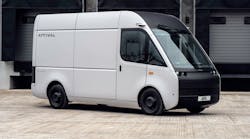The EV start-up Arrival unveiled specs, images, and video of the next phase in the development of its electric van which will be starting public road trials with its UK customers this summer with North American planned for the fall. Following road trials, the timeline shows production starting in Q3 of 2022.
Arrival has been testing its vehicles with drivers for several years now, in its R&D facility and at private proving grounds, Patrick Bion, Arrival’s chief of product, explains. “This will be our first public road trial of the Van with the vehicles in service on actual routes with our customers. We will validate and improve our vehicle’s robustness and usability with a range of drivers in fleets and in a number of conditions,” says Bion. “The van will be used day-in-day-out by drivers so we will be able to test the functionality of the vehicle, software and hardware, charging, fleet management, and service.”
Arrival’s Van offers a best-in-class product, with an elevated experience for both operator and driver, at a price comparable with fossil fuel vehicles, and a superior TCO to both fossil fuel and other EVs. “Unlike most of the EV industry. Arrival uses vertically integrated, in-house technology, building its products from the ground-up, and dramatically reducing production costs,” says Bion. “This combined with Microfactory production drives better unit economics and as a result a lower initial price point than other EVs. Compared to competitor electric vans, the total cost of ownership (TCO) of the Arrival Van is 28% lower than competitor vehicles. This lower initial price point, plus the considerable savings on maintenance over the life of the vehicle, enable this substantially lower TCO.”
Arrival’s proprietary software provides data to the driver and operator through an API that elevates user experience. It also enables remote health monitoring of the vehicle and its core components to allow for predictive maintenance, reducing downtime for the fleet and further enhancing the TCO. The cloud-based tools are also designed to maximize customer ownership experience and allow for over-the-air updates to ensure the product’s function and efficiency gets better over its lifetime.
Arrival’s van also focuses on delivering a new level of comfort to the commercial market—one usually found in luxury passenger vehicles—including heated seating, independent front and rear suspension, full cabin climate control, and a 15.6-in. touch-screen interface to communicate data being collected from the vehicle directly to the driver in an optimal fashion. In addition, Arrival vehicles are designed to maximize the safety and well-being of drivers and the public on our roads and streets using advanced technologies. ADAS features, such as digital e-mirrors, a 360-degree surround view, Advanced Emergency Braking, Blind Spot Monitoring, Traffic Sign Recognition, and Lane Keep Assist are all available across the range of Arrival Van variants, from 5.1 to 6.5 m in length, offering an optimized product for any business or consumer.
Arrival believes it has set a new standard for commercial vehicles by introducing a fully electric van that excels across both payload (1,975 kg) and cargo volume (2.4 m3 per meter in length) at a price comparable with fossil fuel vehicles, and with a substantially lower total cost of ownership (TCO). Arrival’s Van has been developed alongside drivers and operators to maximize functionality for real-world use, with the deployment of advanced in-house technologies throughout the vehicle to provide customers with an elevated connected experience and operators with the data and fleet management tools they need to optimize the running of a fleet.
The components are also upgradeable over time in both hardware and software, ensuring the vehicle stays up to date with the latest technology and extending its use. The flexibility provided by the modular battery ranging from 44 to 133 kWh, means that operators can choose the battery configuration that is best suited for their range requirements, further reducing costs and increasing efficiency. The lightweight aluminum frame and proprietary composite body panels significantly decrease the weight of the vehicle for greater range efficiency, reduce the frequency and cost of repairs as well as extend the van’s life expectancy.
According to Bion, Arrival’s in-house developed materials are 50% of the mass of steel and able to withstand more impact and abrasion before a panel needs replacement, resulting in less frequent service and repair, more time on the road, and a lower TCO. Additionally, Arrival’s thermoplastic-composite materials use an in-mold color, removing the need for painting and expensive or time-consuming repair. In the case of severe damage, the parts can be recycled, creating a truly sustainable product and a circular economy model for vehicle structures.












